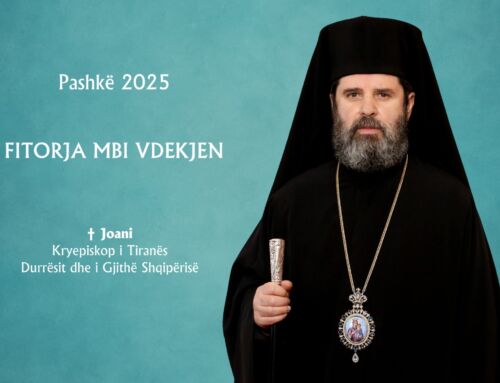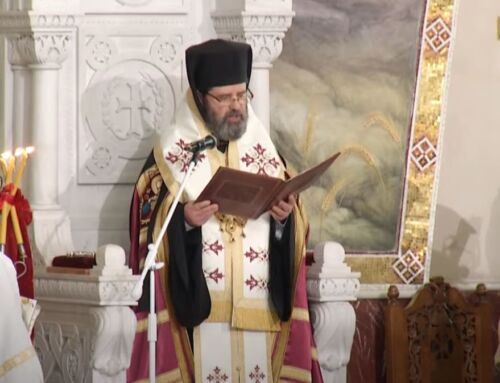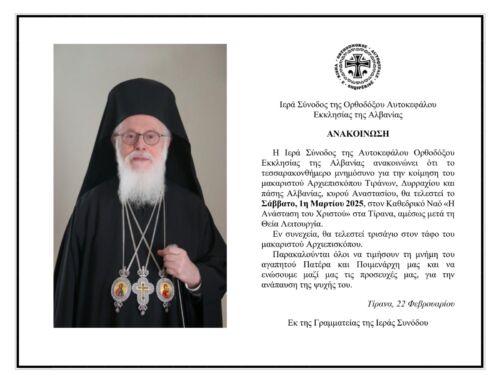Archbishop Anastasios in Shpat, an Area of Orthodox Traditions
On the Feast of the Transfiguration He Celebrated the Divine Liturgy in Gjinar
The sixth of August, the day of the great feast of the Transfiguration of our Savior was a very special one this year for the faithful of Shpati, an area of Orthodox traditions in the Metropolis of Elbasan. On such an occasion, they warmly welcomed His Beatitude, Archbishop Anastasios, who had come to celebrate with them. Archbishop Anastasios arrived on the afternoon of August 5, and in the morning he headed towards the Church of Ascension of our Lord in Gjinar to celebrate the Divine Liturgy. This church was built in 1996 with prefabricated material and was completely reconstructed in 2009, under the care and financial support of His Beatitude.
Lots of faithful from Gjinari and the surrounding areas had come to welcome the Archbishop. It was remarkable the large number of children and youth, as well as the traditional folk costumes worn by the youth of the respective area. Among a festive atmosphere that the folk musical instruments created, the Archbishop headed towards the entrance of the church where he would celebrate the Divine Liturgy together with the Metropolitan of Elbasan, Shpati and Librazhd, His Grace Andon, the Mitropolitan of Amantias, His Grace Nathanail and other clerics of the area.
During the Liturgy, the Archbishop awarded the title ‘Stavrofor’ (‘Cross-bearer’) to Fr. Jani Ranxha, who is the priest of the parish. At the end, he addressed the believers talking about the meaning of that festive day and the close ties he has always had with this province of Orthodox traditions. Then, on behalf of the faithful, Metropolitan Andon thanked His Beatitude for his visit and care shown throughout these years. At the end of the Liturgy, the Grape Blessing took place, a service which is annually conducted on 6 August according to the Orthodox tradition.
After the liturgy, in a beautiful natural setting amid the pine trees, an artistic program was organized with the participation of the day camp children, the characteristic folk bands of the area etc. The participants addressed the Archbishop with warm words of gratitude and extended their heartfelt wishes for everything he has made for them. Afterwards they received his applause and blessings. He even stood up to stand among the dancers, who surrounded him with joy and enthusiasm. In the end, the Archbishop distributed icons and gave his blessings to all the participants.
Archbishop Anastasios also paid a visit to the remote village of Zavalina, despite the high temperatures and the rather damaged road. But before that, His Beatitude stopped in the village of Nezhan, at the home of Fr. Kosta Pellumbi, 94 years old, probably the only cleric still alive from the clergy generation before the 90’s. Then Archbishop Anastasios visited St. George’s Church in Zavaline, where he was received by the faithful and Fr. Sotir Toçi. The service of the Small Paraklisis of the Theotokos was conducted here and later his visit continued to the area administrative unit.
The region of Gjinar is famous for its early Orthodox traditions. It is distinguished for two old churches built in the 16th century in Shelcan and Valsh: St. Nicholas Church and Saint Parashqevi Church painted by Onufri, the great iconographer. The area is also renowned for another unique feature: At the peak of the Ottoman repression, when the village inhabitants were forced to change their belief, many residents were declared as Muslims and changed their names, but they also kept their Christian name and secretly performed the Orthodox rituals. After the Turkish occupation, they massively declared that they were Christians and openly manifested their faith which they had fanatically preserved. After the 90’s, this province was distinguished for the series of ordinations and its numerous clerics as well as many distinguished students from the area who had finished the Theological Academy and the Holy Cross Church Lyceum. In addition to the construction of several churches and youth centers, also numerous development projects have been implemented in this region which still continue to be organized in the present, under the direct care of Archbishop Anastasios and in particular through the Diakonia Agapes Church Office.


